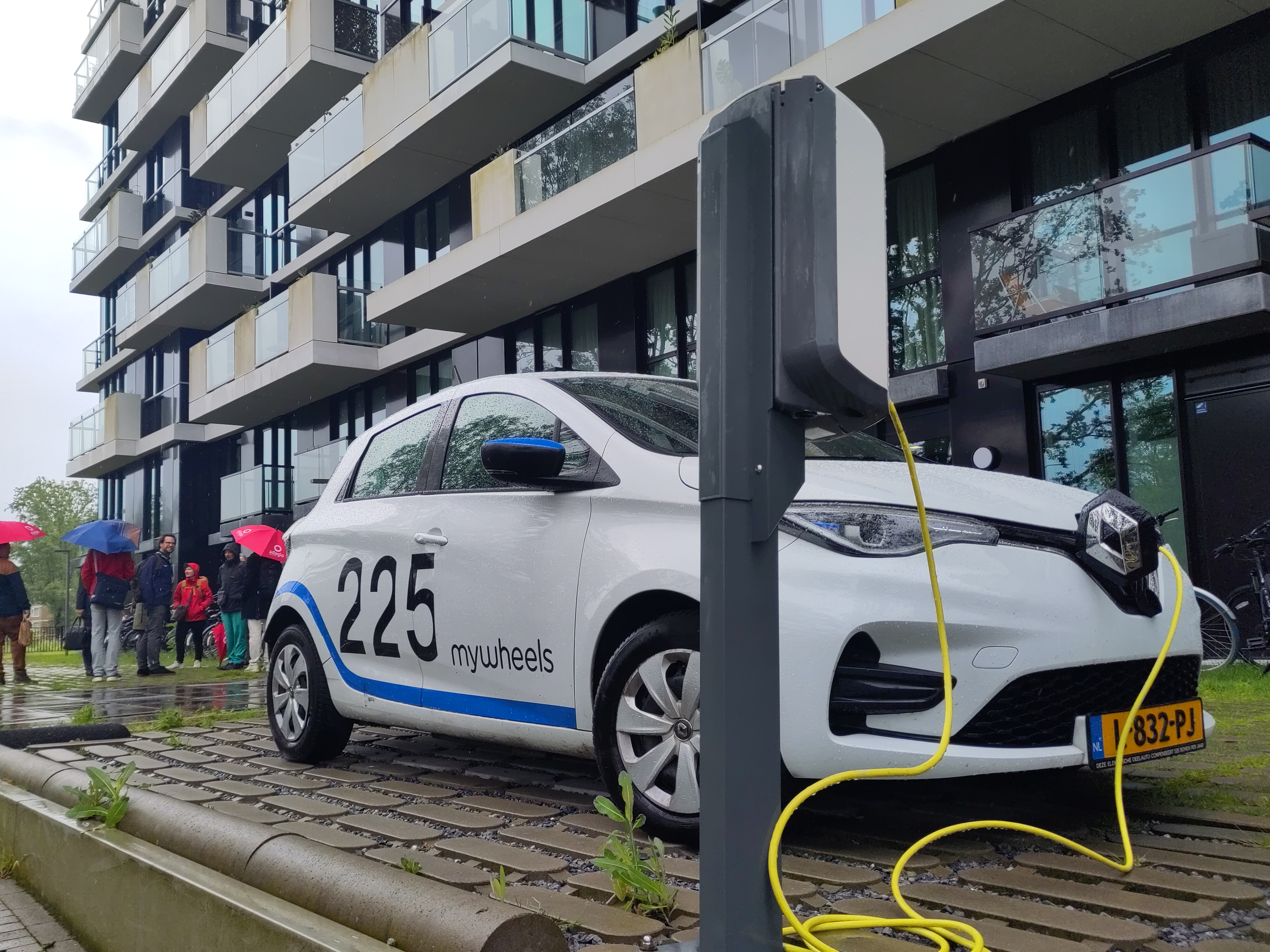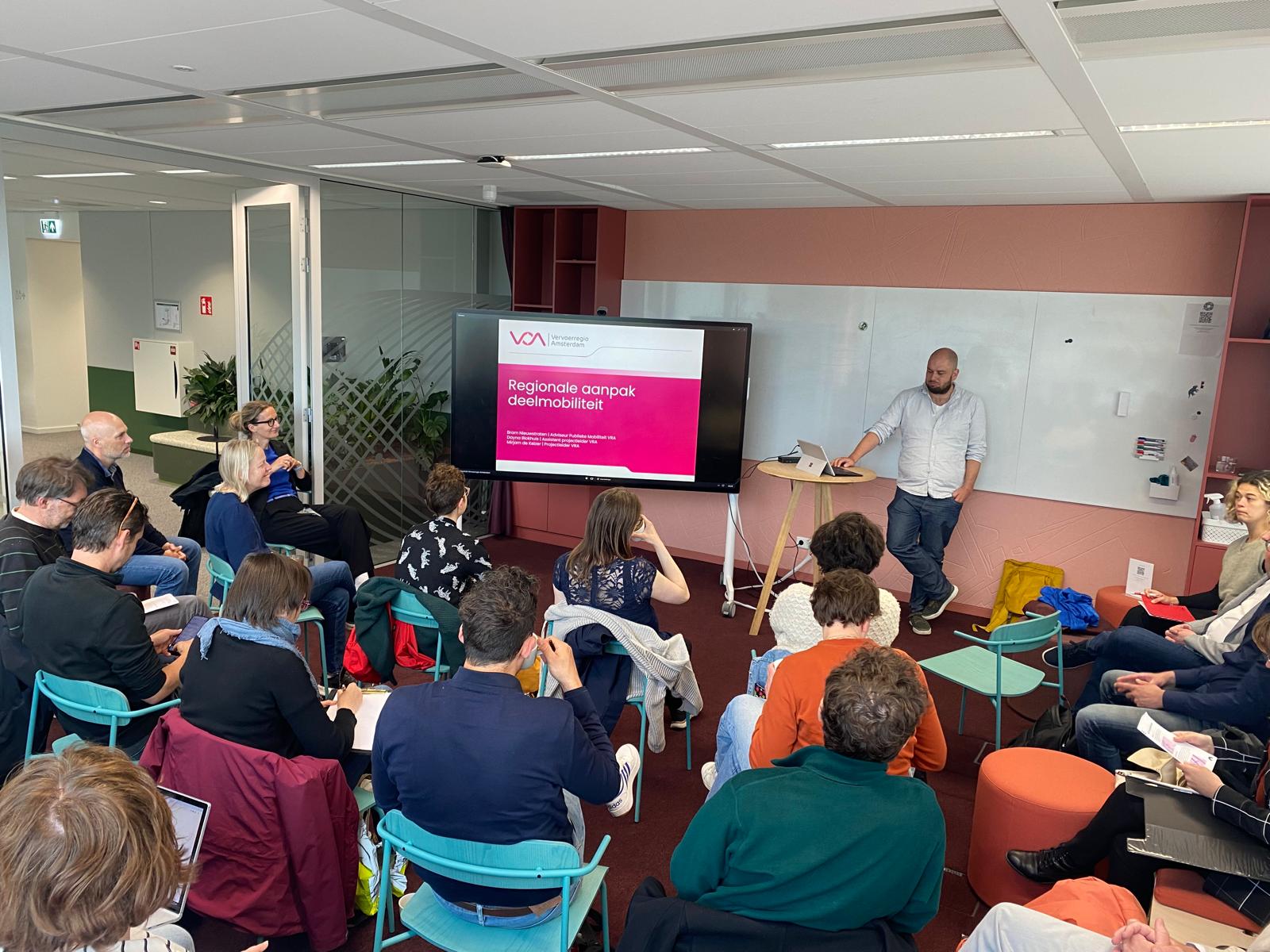How does the approach to shared mobility in Belgium differ from that of the Netherlands? What can we learn from each other to enhance our respective offerings? Project partner Autodelen.net identified the differences and similarities during its two-day study and exchange trip, combining Interreg North Sea Region projectsSHARE-North Squared and ShareDiMobiHub.
In June 2024, a Flemish and Brussels delegation of professionals went on a study trip to Amsterdam. The group visited Amstelveen, walked through the Amsterdam neighbourhoods De Pijp and the Frans Halsbuurt, and were received by the Amsterdam Metropolitan Area and had the chance to discuss also with partners such as Vervoerregio Amsterdam. The biggest conclusion from the study trip? That there are many more similarities than differences.

Similarities: lots of experimentation and research
I. Innovative collaboration is the key to success. Take the TwoTwoFive residential complex in Amstelveen: the project developer worked closely with the municipality in a pilot project within the City Deal ‘Electric Shared Mobility in Urban Development.’ Thanks to the availability of shared cars, the parking standard was halved from 1.4 to 0.7. This frees up more unpaved space and makes housing more affordable. There are already similar examples in Flanders, in Turnhout (Niefhout), Vilvoorde (Vier Fonteinen), Sint-Niklaas (Patershof), and Ghent (Cohousing Schilders). When all different players believe in shared mobility and are willing to collaborate, much is possible.
II. Incentives and positive stimuli alone are not enough to get people into shared cars. As a government, you must also dare to choose shared mobility over private cars, for example with an adjusted parking policy. It helps to make street parking more expensive and to scrap parking spaces. In some suburbs of Amsterdam, for example, the replacement ratio is negative. A shared car is just an extra car that does not encourage reduced car ownership. As long as private cars can still park for free there, this will unfortunately not change.
III.The Netherlands takes a broad view of shared mobility as a complement to public transport. According to the Amsterdam Transport Region, there are three forms:
- Public transport: with a driver and fixed route
- Flexible transport: with a driver, without a fixed route
- Shared transport: without a driver, without a fixed route
These three forms are part of what they call "public mobility" in the Netherlands. In this vision, it is important to organize shared mobility at a regional level, not just at a local level. And just like in the Flemish vision of basic accessibility, it is important to align the three forms well.
IV. Also recognizable is the complexity of policy levels involved in shared mobility and the need for coordination between those levels. The Amsterdam Transport Region, for example, covers 14 municipalities, including Amsterdam, with profiles ranging from very urban to rural. These municipalities have different needs regarding shared mobility, making coordination with the transport region challenging.
V. With good participation, much is possible. A striking example is the Frans Halsbuurt in Amsterdam. The streets are designed for the residents: lots of greenery, and plenty of space for bicycle parking. All 600 parking spaces (!) on the street were removed, and residents now park in an underground parking garage. Cars are allowed to drive through the streets, and there are places for loading and unloading, but leaving your car on the street is no longer possible. Residents were given a say: for example, they did not want picnic tables to avoid noise nuisance from tourists.
VI. Starting with car sharing is a big step, which is why they are working on insights into behaviour change in the Netherlands and Belgium. It is important to work with people's motivations and resistances, for example by letting them test shared mobility for a while. In the Netherlands, there are plans for “try-out actions”; in Flanders, project partner Autodelen.net organizes test moments and test campaigns like Sharing Neighborhoods.

Differences: national program
In the Netherlands, there is a national program from the Ministry to accelerate shared mobility. In 2023, the program ‘Natuurlijk! Deelmobiliteit’ (freely translated: ‘Naturally! Shared Mobility’) started. It aims to ensure coherent policy, knowledge development, monitoring and promotion, and ultimately to accelerate shared mobility. In Belgium, Autodelen.net takes on some of these tasks, but it does not have the mandate or the impact of a national ministry program. On the contrary, the northern neighbours claim lacking an NGO following Autodelen.net´s model to support the national action program.
Local authorities in the Netherlands stimulate cooperative car-sharing through local car-sharing groups. For example, Amsterdam wants to diversify its offer to serve more target groups. Moreover, a diverse offer is interesting to be less dependent on certain providers. The Dutch efforts are striking, especially since Belgium has a longer history of private car-sharing. Dégage and Cozywheels emerged before Cambio became active in Belgium. In the Netherlands, there is Snappcar, which works like Getaround: as an owner, you rent out your car via an online platform like Airbnb. Only at Autodelen.net, we do not consider this car sharing but rather car rental.
A third difference: it seems that the mindset in the Netherlands is more ready for innovative urban planning than ours. The visit to the Frans Halsbuurt made a big impression during our study trip. Removing and making 600 parking spaces underground is a big step. The underground parking is at the edge of the neighbourhood, up to 1.2 km from people's homes. The space shortage must have been pressing, but this need is also high in Brussels, where there was and is strong resistance to Good Move.
This two-day study trip was part of the European Interreg project SHARE-North Squared. The second day also included an exchange with the European Interreg project ShareDiMobiHub.
Text and pictures provided by project partner Autodelen.net.
